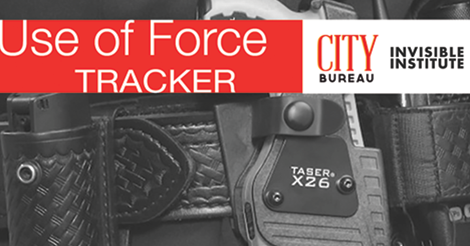Here’s what you, through our Use of Force Tracker, told the Chicago Police Department about their drafted rules on when police can and cannot use force against civilians.
By Darryl Holliday
City Bureau/Invisible Institute
When the Chicago Police Department released a draft of revised Use of Force policies, City Bureau and the Invisible Institute decided to create a tool to make it easier for people to read the draft, understand the context and add their own feedback. In total, over 50 comments, upvotes and responses were logged via our interactive, annotated Use of Force Tracker tool by members of the public during the CPD’s public comment period. (See a full list of comments here.)
Below, we pulled out 12 of those suggestions. For more information, click the link in each comment and see the full annotation.
On reasonable use of force: “The standard of reasonableness must be explicitly defined as reasonableness from the perspective of a citizen. There is a large—and growing — disconnect between what officers view as reasonable and what citizens view as reasonable. This is a concrete change that encourages empathy.”
On choke holds: “A better definition of choke holds is needed. Also, chokes may be necessary to preserve life in the case of a subject who is under the influence of drugs and not responding to pain control. The choke, properly executed, can save the life of an officer and the subject is such a situation.”
On medical attention for those injured by police: “This [directive] would seem to imply that the department will now be required to provide medical training to all officers, equip them with the necessary equipment, and ensure that all training and equipment will remain up-to-date.”
On officer testimony: “There is quite a bit of research that shows that after a traumatic situation such as a deadly force encounter, full recall of an incident may not be possible immediately. The fight-or-flight response may include tunnel vision, auditory exclusion, and impairment of judgment, to name a few. Those who have experienced those symptoms may not be in a position to immediately provide complete details. This policy should be examined closely.”
On holding techniques and passive resistance: “Why are holding techniques permissible for a passive resister who is solely resisting verbally? Verbal resistance should not warrant use of force.”
On the code of silence: “Given the gravity of a violation of use of force, I think it is necessary to identify the sworn member who is using force in violation of this directive as soon as possible.”
On police officers identifying themselves as officers: “This [directive] is unacceptable. Officers should always have to identify themselves if they are on the job and being paid to do said job. Not identifying themselves at all times escalates situations further and jeopardizes the safety of both the community and officer. This must be changed.”
On de-escalation training and techniques: “The de-escalation training for officers has not been effective thus far as Chicago is still paying out millions of dollars of tax payer money to settle cases of use of force. De-escalation is NOT shouting “put the gun down” three or four times before shooting. All CPD officers should be required to take de-escalation training form a licensed clinician (LPC, LCPC, LCSW etc) and NOT a higher ranking officer or employee employed by CPD. Consequently, conflict resolution training should also be included. Additionally, ALL officers should be mandated to spend time in the communities they serve — specifically on the south and west sides of Chicago — off duty and unarmed with the intention of interacting with the community in some form or fashion so they are able to understand how members of the community act, how conflict occurs and how conflict is resolved.”
“What does “immediate” de-escalation look like? I imagine it could look like a more concerted effort to use CIT (Crisis Intervention Team) dispatching, and I would like to see it reflected in the de-escalation plan in these guidelines.”
On proportional response: “‘Proportional’ needs to be explicitly defined so that all officers are clear. Shooting to kill — which has been what has been occurring lately — is not proportional. The use of a Taser to incapacitate a suspect is proportional. Shooting a suspect in the leg is proportional. Emptying a clip on a suspect out of fear is not proportional.”
On race and ethnicity in use of force: “Add: “gender, gender identity, sexual orientation, religion, housing status or other characteristics” to address police violence against women, LGBT, Muslim and homeless people, particularly women, LGBT and homeless people of color,” and “in addition to [above] suggestions, add: citizenship status.”
On use of force against pregnant women: “Based on policies in other jurisdictions, and a number of incidents involving use of force against pregnant women by Chicago police officers, the policy should expressly prohibit use of force on pregnant women and children, including, but not limited to, use of Tasers, take downs, use of force to the abdomen and rear handcuffing.”
On community/police relations: “‘Cooperation’ simply means bowing to the power and being acquiescent. “Collaboration” would be more appropriate, but of course that would require a balanced power level between police and community.”
Support City Bureau’s work to reimagine local news by becoming a City Bureau Press Club member today.
To get twice-monthly emails including Chicago news and events, sign up for City Bureau’s Chicago newsletter.

